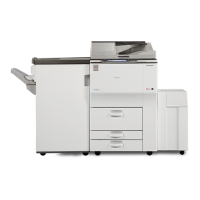If you select [Prohibit], the machine stops during startup when a firmware structure change is
detected and a message requesting administrator login is displayed. After the machine
administrator logs in, the machine finishes startup with the updated firmware.
The administrator can confirm if the updated structure change is permissible or not by checking the
firmware version displayed on the control panel screen. If the firmware structure change is not
permissible, contact your service representative before logging in.
When "Change Firmware Structure" is set to [Prohibit], administrator authentication must be
enabled.
After [Prohibit] is specified, disable administrator authentication. When administrator authentication
is enabled again, you can return the setting to [Do not Prohibit].
If you select [Do not Prohibit], firmware structure change detection is disabled.
Default: [Do not Prohibit]
Password Policy
This can be specified by the user administrator.
This setting lets you specify [Complexity Setting] and [Minimum Character No.] for the password.
By making this setting, you can limit the available passwords to only those that meet the conditions
specified in "Complexity Setting" and "Minimum Character No.".
If you select [Level 1], specify the password using a combination of two types of characters
selected from upper-case letters, lower-case letters, decimal numbers, and symbols such as #.
If you select [Level 2], specify the password using a combination of three types of characters
selected from upper-case letters, lower-case letters, decimal numbers, and symbols such as #.
Default: [Off], Minimum required number of characters not specified
Settings by SNMPv1, v2
This can be specified by the network administrator.
When the machine is accessed using the SNMPv1, v2 protocol, authentication cannot be
performed, allowing machine administrator settings such as the paper setting to be changed. If you
select [Prohibit], the setting can be viewed but not specified with SNMPv1, v2.
Default: [Do not Prohibit]
Device Access Violation
This can be specified by the machine administrator.
If the number of log in requests exceeds the setting, the system classifies the access session as an
access violation. The access session is recorded in the Access Log and the log data is sent to the
machine administrator by e-mail. Also, a message is displayed on the control panel and on Web
Image Monitor.
If the "Max. Allowed No. of Access" is set to [0], over access is not detected.
In "Authentication Delay Time", you can specify response delay time for log-in requests to prevent
the system from becoming unavailable when an access violation is detected.
Specifying the Extended Security Functions
265

